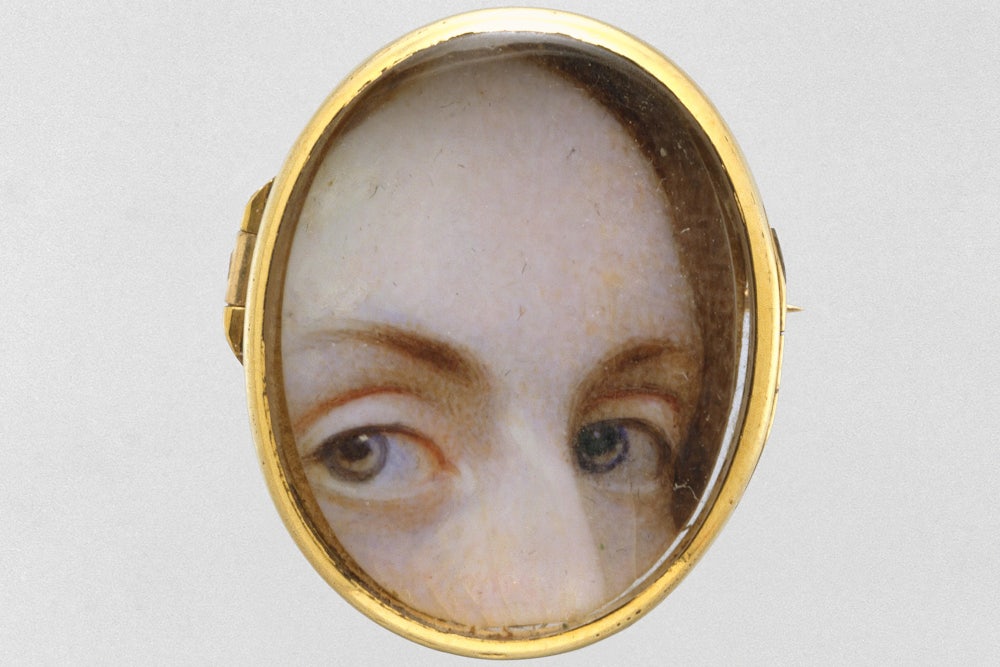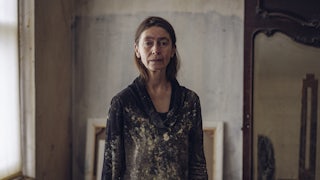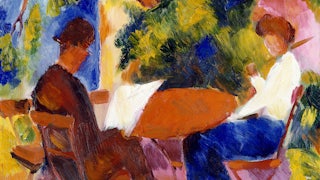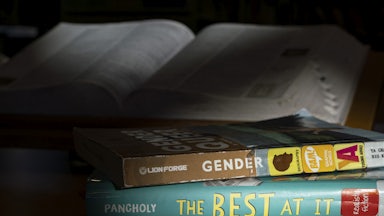In A Sketch of the Past, Virginia Woolf’s brief collection of autobiographical writing, she remarks, of the failures of memoir: “They say this is what happened, but they do not say what the person was like to whom it happened.” Strangers who had died were the easiest for her to conjure and to sketch out for a reader. To describe her mother, who died when Woolf was 13, long felt impossible. Woolf had the feeling “of living so completely in her atmosphere that one never got far enough away from her to see her as a person.” She was so “central,” as Woolf put it, that it was difficult to know her at all.
CM, the narrator of Catherine Lacey’s fourth novel, Biography of X, has the same problem and project. The “X” of the title is a great artist, an outwardly difficult, sometimes cruel woman at the center of a forceful orbit of prestige. In her singular public mystique, she resembles Lydia Tár in Todd Fields’s recent movie, another rendering of an artist and an ego so elusive and so vast that articles have been written just to clarify that she does not actually exist. In a (fictional) interview mid-book, Lacey’s X announces: “I do not ask who am I? but who are I?” A litany of think pieces, interpretations, rebuttals, reinterpretations have written about X, all on roughly the same theme: Who is she?

Like Woolf’s mother, X is both central and unknowable: central because she is not only a prominent figure but CM’s wife; unknowable because though X’s death suggests an end, it also functions as catalyst for CM’s discovering all she never knew about this woman who she loved. This biography is set in a world with nearly all of the same component parts as our own: same place names, politicians, and celebrities; same grievances and fears, but shifted into an alternate version of history (more on that later). Lacey reconfigures this world, it seems, in part, because she is interested in world-building but also because X is meant to be an artist of such extraordinary reach and impact that we can’t be of her world and not already have some sense of her.
All of Lacey’s work until now has explored the ineffability, the incomprehensibility of selfhood, how murky and uncertain we all are at the center; how murky and uncertain our ability to see and love and care for one another is. The title of Lacey’s first novel is Nobody Is Ever Missing; the title of this new book might well be Nobody Is Ever Found. All of her novels have been built around absences and lacks—a sister’s suicide, a disappearance, an unnamed, unraced, ungendered person—but X is both the most intricately constructed and the most ambitious, in the unknown self, the love and art it seeks.
CM does not set out with the intention of searching for and and trying to capture X. Another biographer, male, has written a book about X in which, of course, he’s gotten so much wrong, not least the place and people of X’s origins. “I never intended to write a corrective biography,” CM writes—and the book is told from this retrospective place: We are not on a journey with CM but post years of discovery, with her as she sifts through these years of primary source discovery, as she attempts to give shape to the shock of aftermath. “All I wanted was to find out where my wife had been born … I did not know that by beginning this research I had doomed myself in a thousand ways, that once the box had been opened, it would refuse to be shut.”
Though long since relegated to her wife’s shadow, CM is also a Pulitzer prize–winning crime reporter and has both the chops and the resources for this work. What follows is years of research, trips through Lacey’s intricately built alternative United States, broken up in 1945 into Northern, Southern, and Western territories. X and CM have lived together in New York throughout their marriage, first in the city and then upstate (and here, as well as at many points throughout the novel, their lives’ trajectories are endearingly predictable: the younger wife, the move from the city upstate) in the more progressive (gay marriage has been legal for decades, universal health care, an actual social safety net) Northern Territory—though, not long after X’s death, the wall that separates the South from the North is torn down and North and South are reconnected again.
CM’s first discovery is that X is a rare refugee from the South, having escaped during an attempted terrorist attack. Like much of the rest of the novel’s relationship to history, recognizable proper names and data points, the details around the South’s secession have a prickly, uncanny feel. Combining Mississippi, Alabama, Georgia, the Carolinas, Tennessee, Florida, as well as parts of Virginia, West Virginia, Arkansas, and Louisiana, the ST “had been cooperating for nearly a decade to enact the mass exodus … convinced a majority of Southerners that every state in the north was being secretly controlled by the communist party; an invasion of the South, they said, was imminent … there was no longer any objective truth, a belief that numbed any part of the population that might have objected to the forced theocracy.”
Because this world is not our world, a good amount of the book is spent laying out these terms and history. Lacey reshuffles the world rather than starting from scratch. Here, Emma Goldman, an activist deported under the Anarchist Exclusion Act in real life, becomes chief of staff under FDR and, only later, a martyr; recognizable writers and critics are situated out of time at various recognizable publications. A whole assortment of well-known artists and musicians (RuPaul, David Bowie) collaborate with X. It’s a bold move, not only for what it asks us to believe about X’s influence but in how it asks us to unlearn all we think we know about our past, about the genesis and implications of world events and about thinkers’ and artists’ influence.
The book also uses photographs, many of which are meant to be of X but are not the same person, but also, who can say? A good amount of X’s art involves her inhabiting and then undercutting various aliases. The pictures are old and hazy, and the book is always quick to remind you that fact is not ever the most interesting thing, not ever, really, where whatever truth that we might access lives: “X believed that making fiction was sacred … and she wanted to live in that sanctity, not to be fooled by the flimsiness of perceived reality, which was nothing more than a story that had fooled most of the world.”
The alternative history doesn’t always hold up in the face of questions of logistics—how was “disinformation” disseminated? How much power, really, could a chief of staff have? Why is the rest of the world seemingly unaffected by this reshuffling? The book seems more interested, however, in the complexity and fragility of history as it unfolds, in how the world we know is always a near-collapsing house of cards.
Of course, CM’s questions are not answered when she confirms X is from the Southern Territory, when she tracks back to find her parents (who, like lots of other characters in Catherine Lacey’s novels, turn out not to be her parents after all). These questions are only compounded when CM meets X’s former husband and, after that, speaks to her son. CM keeps searching, peeling back layer after layer of her wife’s life, her first years in the Western and then Northern Territories, her past loves, her many aliases, jobs, disguises, much of which will inform and become her later art.
The art too is not ever fully comprehensible: Is it good? Interesting? On purpose? In Orlando: A Biography—the novel in biography form Woolf wrote right after To the Lighthouse—the title character, Orlando, born male but later female, somehow able to live 300 years, spends portions of the novel chasing a grey goose that is meant to represent the great novel that she fails to write. There’s something of this goose chase in the recounting of X’s projects. Some feel like jokes: produced quickly and explicitly to toy with public perception; some feel earnest, less legible but more deeply felt.
Do they add up to Art, or do they add up to someone trying doggedly to outwit the culture and the public? Art as game? Art as trick or ruse? “All her notes amounted to a single question that (Elvia) Wilk raised and X was unable to resolve—could she both disdain the state of this country’s culture as a whole and still reasonably desire or accept its approval?” Both Orlando and Gertrude Stein’s similarly layered Autobiography of Alice B. Toklas—purportedly Alice writing about Alice, but actually Gertrude using Alice as a lens through which to show herself—lived in this murky space of half-ruse, half–love letter: Both were written quickly, their most commercial books, disparaged by contemporary friends and colleagues; both, at the same time, helped reinvent the form.
Art, Lacey seems to be suggesting, can be lots of things at the same time. An artist and her ego can often overwhelm or even outperform the art. This summer I read the biographies of Joan Didion and Susan Sontag, both of whom often made work that disappointed their peers and themselves. And yet they became Joan Didion and Susan Sontag. Not because of any single book but because of something else maybe ineffable: accrual and attrition, ego, intrigue, beauty, the power of the thinking, the particularity of the ideas.
So who was X, really? And do we ever see or feel her? Do we ever see or understand which of all the hers she was for CM? Early in the book, we’re told that X is monstrous (“From the very start I knew that X possessed an uncommon brutality, something she used in both defense and vengeance”), but, for most of it, we don’t see this up close—we get glimpses; she disappears without notice from CM for days or weeks; she can be withholding, silent, impenetrable—until finally, in the last pages, blood is drawn, a gun is pulled. In both instances, these moments failed, for me, to have the impact that they might have, in part because Lacey has done such a brilliant job of making X impossible to envision, impossible to feel or grasp. (Think here too of the late scenes of Tár—fragmentary and miasmic—her running and her smashed-up face; her relentless will as her whole world begins to fall.)
This opacity feels less like a failure than a necessary consequence of Lacey’s project: If you convince a reader that there’s no such thing as fully seeing, knowing, understanding, it can be that much more difficult to see and know and understand what happens when this person makes choices and acts. It becomes that much more difficult to feel the weight and implications of that action. “Now, nearly a decade later,” CM writes, “the corporeal jolt and fizz I felt in moments such as these is gone, wholly gone, and cannot be reconstructed or felt again. Time takes those sensations away and without them the story seems simpler and we hold that simplicity up and call it clarity.” CM can’t herself access the feelings that the memories hold inside of them, so then they come to feel also like artifacts, other documents accumulated to make the case for all X might have been, but without the “jolt and fizz” of experience. When, later, there is a moment when it appears X might love CM, it feels both true and tragic how late, how far removed, the gesture feels.
There is an ambition in The Biography of X that’s thrilling not least because it shows how endless, how elastic and expansive—at a time when so much storytelling feels constricted, tight and close on a single consciousness—fiction can be. It also makes even clearer how elusive that central and unknowable thing—the lighthouse, the grey goose—is. If I yearned at the end for more visceral proximity to both X and CM, the jolt and fizzle of their wants and needs, maybe that’s also what Lacey suggests art can be: work that painstakingly reconstructs the lacks and absences around us, to make us ache for all things that both art and love might never fully grasp.






